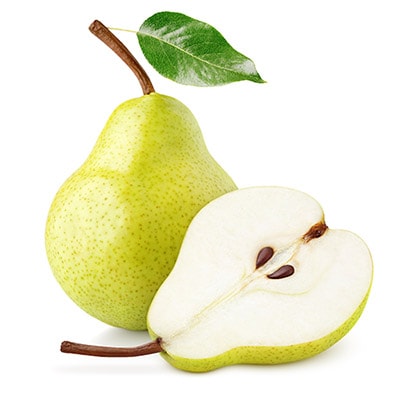With over 3,000 varieties of pears worldwide, the Bartlett pear is the most commonly eaten variety in the United States.
 Background
Background
- Pears belong to the Rosaceae botanical family which also includes apples, stone fruits, and berries.
- Some of the most common pear varieties found at grocers include the Bartlett, Anjou, Asian, and Bosc pears.
- The Bartlett and Anjou pear have green and red varieties available.
- Most pears produced in the United States are grown in Oregon and Washington.
Nutrition
- Pears are an excellent source of fiber and a good source of copper and vitamin C.
- Fiber assists in maintaining bowel regularity, while also helping lower cholesterol levels and control blood sugar levels.
- Copper is an antioxidant which aids in energy production, iron metabolism, nervous system function, and bone formation.
- Vitamin C is an antioxidant which supports wound healing, immune function, and the formation of collagen and connective tissue.
How to Purchase, Prepare, and Store
- Pears are available year-round at grocers. In the Midwest, freshly harvested pears can be found at farmers markets or orchards from late August to early October, depending on variety.
- Choose pears that are firm with smooth skin. They should be free of bruises and blemishes.
- Store pears at room temperature until ripe. Once ripe, you can place in the refrigerator for 2-3 days to extend shelf life.
- It is typical for pears to be unripe when purchased. To speed up the ripening process, place pears in a brown paper bag with a banana. The ethylene gas from the banana quickens the ripening process.
- Pears can be eaten fresh, canned, dried, juiced, or cooked. Add to salads, smoothies, baked good recipes, and jam or jelly recipes.
Nutrition Facts
1 cup pear, raw (140 g)
- Calories: 88.2
- Protein: 0.53 g
- Fat: 0.22 g
- Carbohydrate: 21.1 g
- Fiber: 4.34 g
- Calcium: 11.2 mg w
- Iron: 0.23 mg
- Magnesium: 7.98 mg
- Phosphorus: 14.0 mg
- Folate: 8.4 µg w
- Vitamin A: 1.4 µg
Via fdc.nal.usda.gov
Recipes
Request an Appointment